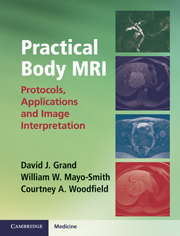Book contents
- Frontmatter
- Contents
- Preface
- To the reader
- Acknowledgments
- Glossary of terms andabbreviations used in Body MRI
- Section 1 Body MRI overview
- Section 2 Abdomen
- Section 3 Pelvis
- Chapter 7 The female pelvis: uterus
- Chapter 8 Adnexa
- Chapter 9 Female urethra
- Chapter 10 Pelvic floor / prolapse
- Chapter 11 Imaging of the pregnant patient
- Chapter 12 MRI of male pelvis
- Chapter 13 Rectal MRI
- Section 4 MRI angiography
- Index
Chapter 13 - Rectal MRI
from Section 3 - Pelvis
Published online by Cambridge University Press: 05 November 2012
- Frontmatter
- Contents
- Preface
- To the reader
- Acknowledgments
- Glossary of terms andabbreviations used in Body MRI
- Section 1 Body MRI overview
- Section 2 Abdomen
- Section 3 Pelvis
- Chapter 7 The female pelvis: uterus
- Chapter 8 Adnexa
- Chapter 9 Female urethra
- Chapter 10 Pelvic floor / prolapse
- Chapter 11 Imaging of the pregnant patient
- Chapter 12 MRI of male pelvis
- Chapter 13 Rectal MRI
- Section 4 MRI angiography
- Index
Summary
Anorectal fistula protocol
Indications
This protocol is used for evaluation of suspected or known anal and rectal fistulas.
Preparation
Patients should not take an enema for 24 hours before the study. They can cause rectal spasm and motion artifact
IV contrast agent: 1 mmol/kg gadopentetate dimeglumine at 2 cc/s
Oral contrast agent: None
Rectal contrast agent: 60 cc ultrasound gel if evaluating for a rectovaginal fistula (Figure 13.1); otherwise, no rectal contrast
Have the patient void prior to the start of the study
The radiologist should be consulted for best plane to visualize pathology
Exam sequences
(1) Sagittal T2 FSE – Use to plan axial and coronal oblique sequences. Make sure that imaging is performed through the entire perineum to ensure complete visualization of fistula tracks.
(2) Axial oblique T2 FSE – Angled perpendicular to rectum or anal canal.
(3) Coronal oblique T2 FSE FS – Angled parallel to rectum or anal canal. T2-weighted images are used to identify fluid within fistulous tracks and abscesses.
(4) Axial oblique volume-interpolated gradient echo BH pre – Angled perpendicular to rectum or anal canal.
(5) Axial oblique volume-interpolated gradient echo BH post IV administration of contrast gadolinium injection at 70 seconds – Angled perpendicular to rectum or anal canal.
(6) Coronal oblique volume-interpolated gradient echo BH post IV administration of contrast at ~2 min. – Angled parallel to rectum or anal canal.
(7) Sagittal volume-interpolated gradient echo BH post IV administration of contrast at ~3 min.
- Type
- Chapter
- Information
- Practical Body MRIProtocols, Applications and Image Interpretation, pp. 132 - 138Publisher: Cambridge University PressPrint publication year: 2012



